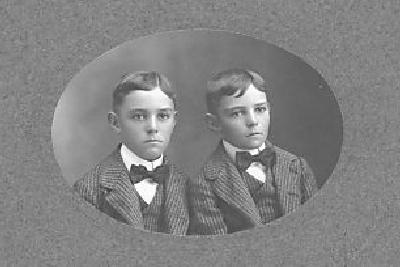
Figure 1.--These two brothers in the 1900s wear bowties. These were solid-colored ties, but we see some boys wearing pattern ties. These boys look about 11-12 years old. |

|
We do notice large numbers of boys wearing bowties being worn in the early 20th century just as large floppy bows were going out of style. They were worn by mostly teenagers at the time. Bowties seem to have been particularly popular in the 1900s. We see many boys wearing them in the formal portraits of the day. While we see quite a number of boys wearing them, we do not see as many boys wearing them as standard neckties. They continued to be popular through the 1920s. Usage declined in the 1930s, but have never entirely disappeared. We note quite a number of boys wearing them again in the 1950s. They tended to be younger boys. I'm not sure why this was, but it was probably because younger boys can not tie neckties. We think that in part because clip-ons became available. Many boys did not know how to tie a necktie. We note that when the term "geek" entered the lexicon we think in the 1980s that along with glasses and plastic pocket protectors, we see suspenders and bowties. We do continue to see little boys wearing them with junior Eton suits. Some fasion concious men wore them as a kind of signature look. This was less true of boys.
We notice large numbers of boys wearing bowties in the early 20th century just as large floppy bows were going out of style. Our ininital assessment is that the number of bowrties increased significantly in the 1900s. We are not sure precisely when this change occurred, but we see loys in large numbers wearing bow ties ar the very early part of the decade. Bowties seem to have been particularly popular in the 1900s. We see many boys wearing them in the formal portraits of the day. While we see quite a number of boys wearing them, but we do not see as many boys wearing them as standard neckties. TYhe bowtie was not aarticularly boyish style. They seem to have been mostly worn by teenagers or boys nearing their teen years, but we notice some younger school age boys as well. We stull note quite a few boys wearing flkoppy bows, especially at the beginning of the decade. We note both solid colored bowties as well as patterns. We are not sure about the actual colors.
A major problem we have in our chronology pages is that the vast majorirty of the photographic record is undated. We note a portrait of the Coras children in Minnesota. A boy in the portarait looks to nbe about 13 years old and wears a bowtie. We tentatively dated the oimage as the 1900s decade, bur are nor entirely sure. In particular ythe older girl's large white haue bow seems moeew of a 1910s style.
Bowties continued to be popular through the 1920s.
Usage declined in the 1930s, but have never entirely disappeared. We notice Arthur Austin Potts wearing his school band uniform with a black bowtie.
|
We notice younger boys in the 1940s beginning to commonly wear bowties. This included both pre-school boys and boys in the ealy years of primary school. Bowties were much less common. Narrow bowties seem to have been much less common. They were all clip-on ties. We are not sure when clip-ons first became available, but they were definitely being widely worn by the 1940s.
We note quite a number of boys wearing them again in the 1950s. They tended to be younger boys. I'm not sure why this was, but it was probably because younger boys can not tie neckties. We think that in part because clip-ons became available. Many boys did not know how to tie a necktie.
We note that when the term "geek" entered the lexicon we think in the 1980s that along with glasses and plastic pocket protectors, we see suspenders and bowties. We do continue to see little boys wearing them with junior Eton suits. Some fasion concious men wore them as a kind of signature look. This was less true of boys.
Navigate the Boys' Historical Clothing Web Site:
[Return to the Main U.S. bowtie chronology page]
[Return to the Main U.S. bowtie page]
[Return to the Main bowtie page]
[Return to the Main U.S. country garment page]
[Introduction]
[Activities]
[Biographies]
[Chronology]
[Clothing styles]
[Countries]
[Bibliographies]
[Contributions]
[FAQs]
[Glossary]
[Images]
[Links]
[Registration]
[Tools]
[Boys' Clothing Home]
